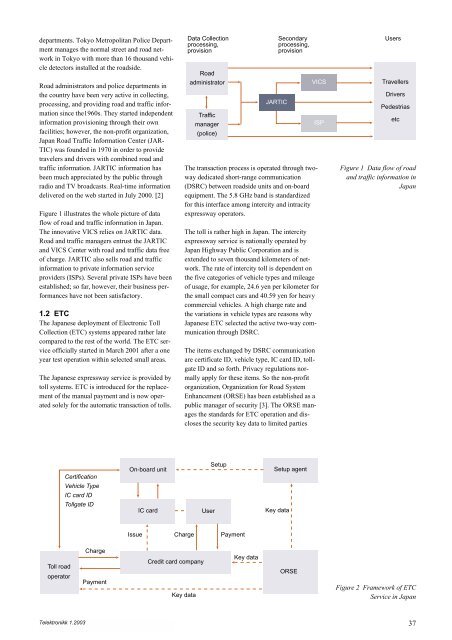Intelligent Transport Systems - Telenor
Intelligent Transport Systems - Telenor
Intelligent Transport Systems - Telenor
You also want an ePaper? Increase the reach of your titles
YUMPU automatically turns print PDFs into web optimized ePapers that Google loves.
departments. Tokyo Metropolitan Police Department<br />
manages the normal street and road network<br />
in Tokyo with more than 16 thousand vehicle<br />
detectors installed at the roadside.<br />
Road administrators and police departments in<br />
the country have been very active in collecting,<br />
processing, and providing road and traffic information<br />
since the1960s. They started independent<br />
information provisioning through their own<br />
facilities; however, the non-profit organization,<br />
Japan Road Traffic Information Center (JAR-<br />
TIC) was founded in 1970 in order to provide<br />
travelers and drivers with combined road and<br />
traffic information. JARTIC information has<br />
been much appreciated by the public through<br />
radio and TV broadcasts. Real-time information<br />
delivered on the web started in July 2000. [2]<br />
Figure 1 illustrates the whole picture of data<br />
flow of road and traffic information in Japan.<br />
The innovative VICS relies on JARTIC data.<br />
Road and traffic managers entrust the JARTIC<br />
and VICS Center with road and traffic data free<br />
of charge. JARTIC also sells road and traffic<br />
information to private information service<br />
providers (ISPs). Several private ISPs have been<br />
established; so far, however, their business performances<br />
have not been satisfactory.<br />
1.2 ETC<br />
The Japanese deployment of Electronic Toll<br />
Collection (ETC) systems appeared rather late<br />
compared to the rest of the world. The ETC service<br />
officially started in March 2001 after a one<br />
year test operation within selected small areas.<br />
The Japanese expressway service is provided by<br />
toll systems. ETC is introduced for the replacement<br />
of the manual payment and is now operated<br />
solely for the automatic transaction of tolls.<br />
Toll road<br />
operator<br />
Certification<br />
Vehicle Type<br />
IC card ID<br />
Tollgate ID<br />
Telektronikk 1.2003<br />
Charge<br />
Payment<br />
On-board unit<br />
IC card<br />
Data Collection<br />
processing,<br />
provision<br />
Road<br />
administrator<br />
Traffic<br />
manager<br />
(police)<br />
JARTIC<br />
Secondary<br />
processing,<br />
provision<br />
The transaction process is operated through twoway<br />
dedicated short-range communication<br />
(DSRC) between roadside units and on-board<br />
equipment. The 5.8 GHz band is standardized<br />
for this interface among intercity and intracity<br />
expressway operators.<br />
The toll is rather high in Japan. The intercity<br />
expressway service is nationally operated by<br />
Japan Highway Public Corporation and is<br />
extended to seven thousand kilometers of network.<br />
The rate of intercity toll is dependent on<br />
the five categories of vehicle types and mileage<br />
of usage, for example, 24.6 yen per kilometer for<br />
the small compact cars and 40.59 yen for heavy<br />
commercial vehicles. A high charge rate and<br />
the variations in vehicle types are reasons why<br />
Japanese ETC selected the active two-way communication<br />
through DSRC.<br />
The items exchanged by DSRC communication<br />
are certificate ID, vehicle type, IC card ID, tollgate<br />
ID and so forth. Privacy regulations normally<br />
apply for these items. So the non-profit<br />
organization, Organization for Road System<br />
Enhancement (ORSE) has been established as a<br />
public manager of security [3]. The ORSE manages<br />
the standards for ETC operation and discloses<br />
the security key data to limited parties<br />
Issue Charge Payment<br />
Credit card company<br />
Key data<br />
User<br />
Setup<br />
Key data<br />
Setup agent<br />
Key data<br />
ORSE<br />
VICS Travellers<br />
ISP<br />
Users<br />
Drivers<br />
Pedestrias<br />
etc<br />
Figure 1 Data flow of road<br />
and traffic information in<br />
Japan<br />
Figure 2 Framework of ETC<br />
Service in Japan<br />
37
















